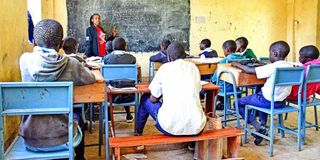Why pioneer CBC students face an uncertain future

A Grade 7 class at Korara Special School and Junior Secondary School, Bomet, in September 2023.
That the Ministry of Education has released close to Sh4 billion to slightly over 19,000 junior secondary school (JSS) institutions for infrastructural development—mainly classrooms for Grade 9 students—is commendable. But with almost 1.3 million students, assuming an enrollment of 50 per class, at least 26,000 classrooms are required.
At an estimated average cost of Sh700,000 per classroom, Sh18.2 billion will have to be spent. It would be a great step forward if a similar sum could be released on a quarterly basis to facilitate this construction well before January 2025.
But teaching and learning is not about infrastructure alone. Teachers, teaching aids and equipment are equally essential. Unfortunately, as the year ends, the teachers employed for JSS are barely one or two for 14 subjects in a single stream—compared to about six in most private schools.
Primary schools traditionally never had laboratories and workshops, implying that JSS students have no exposure to science equipment at all. If, as it now seems likely, the students spend three of six years studying integrated science subjects theoretically, then most of them will not qualify to take science-based courses at the university. Yet the aim of the government is to have 60 per cent of the students do so, thus negating the original aim of introducing the Competency Based Curriculum (CBC).
This challenge needs to be addressed immediately.
There is a category of schools that are lost in public discourse on transition of pupils from primary schools to JSS. These are close to 4,000 primary schools that did not qualify to host JSS. The government has not addressed their plight. Who will fund them to progressively qualify to offer JSS in future?
Does the ministry plan to budget for them? Are MPs expected to use the Constituency Development Fund to upgrade them? Is there any understanding between the ministries of Education and Planning and MPs along these lines or are they forgotten?
And there are issues that need to be addressed before the senior secondary school (SSS) pioneers enrol in January 2026. For example, what are the criteria for selecting students to join SSS? Will the JSS assessment results matter in this transition?
How are the SSS institutions expected to choose the curriculum pathways for their students? What restrictions or control measures has the government put in place to ensure the costly pathways are not forsaken due to lack of the requisite resources to offer them?
Could schools that venture to offer the costly pathways be awarded higher capitation—similar to the new university funding model’s recognition of science- and technology-based courses as costlier?
What does the proposed abolition of national schools portend for the development of science and technical education in view of their superiority in endowment of laboratories, workshops and teachings and learning facilities in general?
Kenyans look up to the Education ministry to guide them through this labyrinth.
Mr Sogomo, an education expert, is a former secretary of TSC. [email protected]. @Bsogomo





